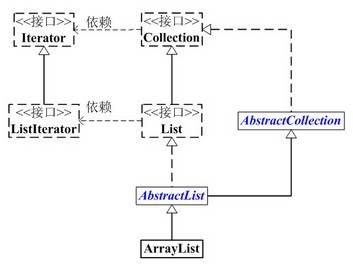Java重要类详解之ArrayList类
来源:互联网 发布:花生壳linux 编辑:程序博客网 时间:2024/06/06 03:12
一.ArrayList概述
- ArrayList 是一个数组队列,相当于动态数组。与Java中的数组相比,它的容量能动态增长。它继承于AbstractList,实现了List,RandomAccess[随机访问],Cloneable[可克隆], java.io.Serializable[序列化]这些接口。
- ArrayList 继承了AbstractList,实现了List。它是一个数组队列,提供了相关的添加、删除、修改、遍历等功能。
- ArrayList 实现了RandmoAccess接口,即提供了随机访问功能。RandmoAccess是java中用来被List实现,为List提供快速访问功能的。在ArrayList中,我们即可以通过元素的序号快速获取元素对象;这就是快速随机访问。稍后,我们会比较List的“快速随机访问”和“通过Iterator迭代器访问”的效率。
- ArrayList 实现了Cloneable接口,即覆盖了函数clone(),能被克隆。
- ArrayList 实现java.io.Serializable接口,这意味着ArrayList支持序列化,能通过序列化去传输。
- 和Vector不同,ArrayList中的操作不是线程安全的。所以,建议在单线程中才使用ArrayList,而在多线程中可以选择Vector或者CopyOnWriteArrayList。

二.ArrayList之API
1.ArrayList和Collection之间的关系

*实线代表直接继承的父类,虚线代表实现的接口;
2.ArrayList类的API
<span style="font-family:Microsoft YaHei;">// Collection中定义的APIboolean add(E object)//添加一个数组对象boolean addAll(Collection<? extends E> collection)//添加一个包含Collection的对象void clear()//清空boolean contains(Object object)//包含boolean containsAll(Collection<?> collection)boolean equals(Object object)//判等int hashCode()boolean isEmpty()//判空Iterator<E> iterator()boolean remove(Object object)//删除boolean removeAll(Collection<?> collection)boolean retainAll(Collection<?> collection)int size()<T> T[] toArray(T[] array)Object[] toArray()// AbstractCollection中定义的APIvoid add(int location, E object)boolean addAll(int location, Collection<? extends E> collection)E get(int location)//获取某个元素值int indexOf(Object object)int lastIndexOf(Object object)ListIterator<E> listIterator(int location)ListIterator<E> listIterator()E remove(int location)E set(int location, E object)List<E> subList(int start, int end)// ArrayList新增的APIObject clone()//void ensureCapacity(int minimumCapacity)//保证容量不小于元素个数void trimToSize()void removeRange(int fromIndex, int toIndex)</span>
3.ArrayList的源码解析
<span style="font-family:Microsoft YaHei;">package java.util;public class ArrayList<E> extends AbstractList<E> implements List<E>, RandomAccess, Cloneable, java.io.Serializable{ // 序列版本号 private static final long serialVersionUID = 8683452581122892189L; // 保存ArrayList中数据的数组 private transient Object[] elementData; // ArrayList中实际数据的数量 private int size; // ArrayList带容量大小的构造函数。 public ArrayList(int initialCapacity) { super(); if (initialCapacity < 0) throw new IllegalArgumentException("Illegal Capacity: "+ initialCapacity); // 新建一个数组 this.elementData = new Object[initialCapacity]; } // ArrayList构造函数。默认容量是10。 public ArrayList() { this(10); } // 创建一个包含collection的ArrayList public ArrayList(Collection<? extends E> c) { elementData = c.toArray(); size = elementData.length; // c.toArray might (incorrectly) not return Object[] (see 6260652) if (elementData.getClass() != Object[].class) elementData = Arrays.copyOf(elementData, size, Object[].class); } // 将当前容量值设为 =实际元素个数 public void trimToSize() { modCount++; int oldCapacity = elementData.length; if (size < oldCapacity) { elementData = Arrays.copyOf(elementData, size); } } // 确定ArrarList的容量。 // 若ArrayList的容量不足以容纳当前的全部元素,设置 新的容量=“(原始容量x3)/2 + 1” public void ensureCapacity(int minCapacity) { // 将“修改统计数”+1 modCount++; int oldCapacity = elementData.length; // 若当前容量不足以容纳当前的元素个数,设置 新的容量=“(原始容量x3)/2 + 1” if (minCapacity > oldCapacity) { Object oldData[] = elementData; int newCapacity = (oldCapacity * 3)/2 + 1; if (newCapacity < minCapacity) newCapacity = minCapacity; elementData = Arrays.copyOf(elementData, newCapacity); } } // 添加元素e public boolean add(E e) { // 确定ArrayList的容量大小 ensureCapacity(size + 1); // Increments modCount!! // 添加e到ArrayList中 elementData[size++] = e; return true; } // 返回ArrayList的实际大小 public int size() { return size; } // 返回ArrayList是否包含Object(o) public boolean contains(Object o) { return indexOf(o) >= 0; } // 返回ArrayList是否为空 public boolean isEmpty() { return size == 0; } // 正向查找,返回元素的索引值 public int indexOf(Object o) { if (o == null) { for (int i = 0; i < size; i++) if (elementData[i]==null) return i; } else { for (int i = 0; i < size; i++) if (o.equals(elementData[i])) return i; } return -1; } // 反向查找,返回元素的索引值 public int lastIndexOf(Object o) { if (o == null) { for (int i = size-1; i >= 0; i--) if (elementData[i]==null) return i; } else { for (int i = size-1; i >= 0; i--) if (o.equals(elementData[i])) return i; } return -1; } // 反向查找(从数组末尾向开始查找),返回元素(o)的索引值 public int lastIndexOf(Object o) { if (o == null) { for (int i = size-1; i >= 0; i--) if (elementData[i]==null) return i; } else { for (int i = size-1; i >= 0; i--) if (o.equals(elementData[i])) return i; } return -1; } // 返回ArrayList的Object数组 public Object[] toArray() { return Arrays.copyOf(elementData, size); } // 返回ArrayList的模板数组。所谓模板数组,即可以将T设为任意的数据类型 public <T> T[] toArray(T[] a) { // 若数组a的大小 < ArrayList的元素个数; // 则新建一个T[]数组,数组大小是“ArrayList的元素个数”,并将“ArrayList”全部拷贝到新数组中 if (a.length < size) return (T[]) Arrays.copyOf(elementData, size, a.getClass()); // 若数组a的大小 >= ArrayList的元素个数; // 则将ArrayList的全部元素都拷贝到数组a中。 System.arraycopy(elementData, 0, a, 0, size); if (a.length > size) a[size] = null; return a; } // 获取index位置的元素值 public E get(int index) { RangeCheck(index); return (E) elementData[index]; } // 设置index位置的值为element public E set(int index, E element) { RangeCheck(index); E oldValue = (E) elementData[index]; elementData[index] = element; return oldValue; } // 将e添加到ArrayList中 public boolean add(E e) { ensureCapacity(size + 1); // Increments modCount!! elementData[size++] = e; return true; } // 将e添加到ArrayList的指定位置 public void add(int index, E element) { if (index > size || index < 0) throw new IndexOutOfBoundsException( "Index: "+index+", Size: "+size); ensureCapacity(size+1); // Increments modCount!! System.arraycopy(elementData, index, elementData, index + 1, size - index); elementData[index] = element; size++; } // 删除ArrayList指定位置的元素 public E remove(int index) { RangeCheck(index); modCount++; E oldValue = (E) elementData[index]; int numMoved = size - index - 1; if (numMoved > 0) System.arraycopy(elementData, index+1, elementData, index, numMoved); elementData[--size] = null; // Let gc do its work return oldValue; } // 删除ArrayList的指定元素 public boolean remove(Object o) { if (o == null) { for (int index = 0; index < size; index++) if (elementData[index] == null) { fastRemove(index); return true; } } else { for (int index = 0; index < size; index++) if (o.equals(elementData[index])) { fastRemove(index); return true; } } return false; } // 快速删除第index个元素 private void fastRemove(int index) { modCount++; int numMoved = size - index - 1; // 从"index+1"开始,用后面的元素替换前面的元素。 if (numMoved > 0) System.arraycopy(elementData, index+1, elementData, index, numMoved); // 将最后一个元素设为null elementData[--size] = null; // Let gc do its work } // 删除元素 public boolean remove(Object o) { if (o == null) { for (int index = 0; index < size; index++) if (elementData[index] == null) { fastRemove(index); return true; } } else { // 便利ArrayList,找到“元素o”,则删除,并返回true。 for (int index = 0; index < size; index++) if (o.equals(elementData[index])) { fastRemove(index); return true; } } return false; } // 清空ArrayList,将全部的元素设为null public void clear() { modCount++; for (int i = 0; i < size; i++) elementData[i] = null; size = 0; } // 将集合c追加到ArrayList中 public boolean addAll(Collection<? extends E> c) { Object[] a = c.toArray(); int numNew = a.length; ensureCapacity(size + numNew); // Increments modCount System.arraycopy(a, 0, elementData, size, numNew); size += numNew; return numNew != 0; } // 从index位置开始,将集合c添加到ArrayList public boolean addAll(int index, Collection<? extends E> c) { if (index > size || index < 0) throw new IndexOutOfBoundsException( "Index: " + index + ", Size: " + size); Object[] a = c.toArray(); int numNew = a.length; ensureCapacity(size + numNew); // Increments modCount int numMoved = size - index; if (numMoved > 0) System.arraycopy(elementData, index, elementData, index + numNew, numMoved); System.arraycopy(a, 0, elementData, index, numNew); size += numNew; return numNew != 0; } // 删除fromIndex到toIndex之间的全部元素。 protected void removeRange(int fromIndex, int toIndex) { modCount++; int numMoved = size - toIndex; System.arraycopy(elementData, toIndex, elementData, fromIndex, numMoved); // Let gc do its work int newSize = size - (toIndex-fromIndex); while (size != newSize) elementData[--size] = null; } private void RangeCheck(int index) { if (index >= size) throw new IndexOutOfBoundsException( "Index: "+index+", Size: "+size); } // 克隆函数 public Object clone() { try { ArrayList<E> v = (ArrayList<E>) super.clone(); // 将当前ArrayList的全部元素拷贝到v中 v.elementData = Arrays.copyOf(elementData, size); v.modCount = 0; return v; } catch (CloneNotSupportedException e) { // this shouldn't happen, since we are Cloneable throw new InternalError(); } } // java.io.Serializable的写入函数 // 将ArrayList的“容量,所有的元素值”都写入到输出流中 private void writeObject(java.io.ObjectOutputStream s) throws java.io.IOException{ // Write out element count, and any hidden stuff int expectedModCount = modCount; s.defaultWriteObject(); // 写入“数组的容量” s.writeInt(elementData.length); // 写入“数组的每一个元素” for (int i=0; i<size; i++) s.writeObject(elementData[i]); if (modCount != expectedModCount) { throw new ConcurrentModificationException(); } } // java.io.Serializable的读取函数:根据写入方式读出 // 先将ArrayList的“容量”读出,然后将“所有的元素值”读出 private void readObject(java.io.ObjectInputStream s) throws java.io.IOException, ClassNotFoundException { // Read in size, and any hidden stuff s.defaultReadObject(); // 从输入流中读取ArrayList的“容量” int arrayLength = s.readInt(); Object[] a = elementData = new Object[arrayLength]; // 从输入流中将“所有的元素值”读出 for (int i=0; i<size; i++) a[i] = s.readObject(); }}</span>重点总结:
- ArrayList 实际上是通过一个数组去保存数据的。当我们构造ArrayList时;若使用默认构造函数,则ArrayList的默认容量大小是10。
- 当ArrayList容量不足以容纳全部元素时,ArrayList会重新设置容量:新的容量=“(原始容量x3)/2 + 1”。
- ArrayList的克隆函数,即是将全部元素克隆到一个数组中。
- ArrayList实现java.io.Serializable的方式。当写入到输出流时,先写入“容量”,再依次写入“每一个元素”;当读出输入流时,先读取“容量”,再依次读取“每一个元素”。
三.ArrayList的使用实例
1.ArrayList的添加
将字符a添加到list当中
<span style="font-family:Microsoft YaHei;">package com.ArrayList;import java.util.ArrayList;/** * @author shengmingqijiquan * @since 2016.09.23 * * */public class MyArrayList{public static void main(String[] args) {ArrayList<String> list = new ArrayList<String>();list.add("a");//按照顺序依次添加。将a添加到list中System.out.println(list+" ");list.add(1,"b");//在第1个元素后面添加E,ArrayList中必须有足够多的数据,例如ArrayList中没有任何数据,这个时候使用arraylist.add(1, "E");就会出现java.lang.IndexOutOfBoundsException异常。System.out.println(list+" ");ArrayList<String> list1 = new ArrayList<String>();list1.addAll(list);//将list中的全部数据添加到list1中System.out.println(list1+" ");list1.addAll(1,list);//将一个ArrayList中的所有数据添加到另外一个ArraList中的第1个元素之后System.out.println(list1+" ");} }</span>运行结果:
2.ArrayList的删除
<span style="font-family:Microsoft YaHei;">package com.ArrayList;import java.util.ArrayList;/** * @author shengmingqijiquan * @since 2016.09.23 * * */public class ArrrayListRemove {public static void main(String[] args) {ArrayList<String> list = new ArrayList<String>();list.add("a");list.add("b");list.add("c");list.add("d");list.add("e");System.out.println(list+" ");//1.按照内容删除单个数据.注意:对于int,String,char这样的原始类型数据是可以删除的,但是对于复杂对象,例如自己编写的User类、Person类对象,需要重写equals方法,负责remove方法无法匹配删除。list.remove("a");//将list中的数据"d"删除 System.out.println("删除单个数据a:"+list);//2.按照集合同时删除多个数据ArrayList<String> list1 = new ArrayList<String>();list1.add("a");list1.add("b");list.removeAll(list1);//按照list1的数据删除listSystem.out.println("删除多个数据后,清空之前 "+list);//3.清空ArrayListlist.clear();System.out.println("清空之后 "+list);}}</span>运行结果:
3.ArrayList的修改
<span style="font-family:Microsoft YaHei;">package com.ArrayList;import java.util.ArrayList;/** * @author shengmingqijiquan * @date 2016.09.23 * */public class ArrayListSet {public static void main(String[] args) {ArrayList<String> list = new ArrayList<>();list.add("a");list.add("b");list.add("c");list.add("d");list.add("e");System.out.println("修改前"+list);list.set(1,"f");list.set(2,"g");System.out.println("修改后"+list);}}</span>运行结果:
4.ArrayList的查询
<span style="font-family:Microsoft YaHei;">package com.ArrayList;import java.util.ArrayList;/** * @author shengmingqijiquan * @date 2016.09.23 * */public class ArrayListGet {public static void main(String[] args) {ArrayList<String> list = new ArrayList<>();list.add("a");list.add("b");list.add("c");list.add("d");list.add("e");System.out.println("初始化数组:"+list);String ele = list.get(1);System.out.println("查询到的元素ele:"+ele);}}</span>运行结果:
5.ArrayList的遍历
ArrayList支持3种遍历方式
- 第一种,通过迭代器遍历。即通过Iterator去遍历
<span style="font-family:Microsoft YaHei;">Integer value = null;Iterator iter = list.iterator();while (iter.hasNext()) { value = (Integer)iter.next();}</span>- 第二种,随机访问,通过索引值去遍历
<span style="font-family:Microsoft YaHei;">Integer value = null;int size = list.size();for (int i=0; i<size; i++) { value = (Integer)list.get(i); }</span>- 第三种,for循环遍历
<span style="font-family:Microsoft YaHei;">Integer value = null;for (Integer integ:list) { value = integ;}</span>比较这三种遍历方式的效率
<span style="font-family:Microsoft YaHei;">import java.util.*;import java.util.concurrent.*;/* * @title ArrayList遍历方式和效率的测试程序。 * * @author shengmingqijiquan */public class ArrayListRandomAccessTest { public static void main(String[] args) { List list = new ArrayList(); for (int i=0; i<100000; i++) list.add(i); //isRandomAccessSupported(list); iteratorThroughRandomAccess(list) ; iteratorThroughIterator(list) ; iteratorThroughFor2(list) ; } private static void isRandomAccessSupported(List list) { if (list instanceof RandomAccess) { System.out.println("RandomAccess implemented!"); } else { System.out.println("RandomAccess not implemented!"); } } public static void iteratorThroughRandomAccess(List list) { long startTime; long endTime; startTime = System.currentTimeMillis(); for (int i=0; i<list.size(); i++) { list.get(i); } endTime = System.currentTimeMillis(); long interval = endTime - startTime; System.out.println("iteratorThroughRandomAccess:" + interval+" ms"); } public static void iteratorThroughIterator(List list) { long startTime; long endTime; startTime = System.currentTimeMillis(); for(Iterator iter = list.iterator(); iter.hasNext(); ) { iter.next(); } endTime = System.currentTimeMillis(); long interval = endTime - startTime; System.out.println("iteratorThroughIterator:" + interval+" ms"); } public static void iteratorThroughFor2(List list) { long startTime; long endTime; startTime = System.currentTimeMillis(); for(Object obj:list) endTime = System.currentTimeMillis(); long interval = endTime - startTime; System.out.println("iteratorThroughFor2:" + interval+" ms"); }}</span> 运行结果:iteratorThroughRandomAccess:3 ms
iteratorThroughIterator:8 ms
iteratorThroughFor2:5 ms
由此可见,遍历ArrayList时,使用随机访问(即,通过索引序号访问)效率最高,而使用迭代器的效率最低!
6.ArrayList之toArray()补充
当我们调用ArrayList中的 toArray(),可能遇到过抛出“java.lang.ClassCastException”异常的情况。下面我们说说这是怎么回事。
ArrayList提供了2个toArray()函数:Object[] toArray()<T> T[] toArray(T[] contents)。调用 toArray() 函数会抛出“java.lang.ClassCastException”异常,但是调用 toArray(T[] contents) 能正常返回 T[]。
toArray() 会抛出异常是因为 toArray() 返回的是 Object[] 数组,将 Object[] 转换为其它类型(如如,将Object[]转换为的Integer[])则会抛出“java.lang.ClassCastException”异常,因为Java不支持向下转型。具体的可以参考前面ArrayList.java的源码介绍部分的toArray()。
解决该问题的办法是调用 <T> T[] toArray(T[] contents) , 而不是 Object[] toArray()。
ArrayList提供了2个toArray()函数:Object[] toArray()<T> T[] toArray(T[] contents)。调用 toArray() 函数会抛出“java.lang.ClassCastException”异常,但是调用 toArray(T[] contents) 能正常返回 T[]。
toArray() 会抛出异常是因为 toArray() 返回的是 Object[] 数组,将 Object[] 转换为其它类型(如如,将Object[]转换为的Integer[])则会抛出“java.lang.ClassCastException”异常,因为Java不支持向下转型。具体的可以参考前面ArrayList.java的源码介绍部分的toArray()。
解决该问题的办法是调用 <T> T[] toArray(T[] contents) , 而不是 Object[] toArray()。
调用 toArray(T[] contents) 返回T[]的可以通过以下几种方式实现。
<span style="font-family:Microsoft YaHei;">// toArray(T[] contents)调用方式一public static Integer[] vectorToArray1(ArrayList<Integer> v) { Integer[] newText = new Integer[v.size()]; v.toArray(newText); return newText;}// toArray(T[] contents)调用方式二。最常用!public static Integer[] vectorToArray2(ArrayList<Integer> v) { Integer[] newText = (Integer[])v.toArray(new Integer[0]); return newText;}// toArray(T[] contents)调用方式三public static Integer[] vectorToArray3(ArrayList<Integer> v) { Integer[] newText = new Integer[v.size()]; Integer[] newStrings = (Integer[])v.toArray(newText); return newStrings;}</span>7.ArrayList综合实例
import java.util.*;
<span style="font-family:Microsoft YaHei;">/* * @title ArrayList常用API的测试程序 * @author shengmingqijiquan * @email 1127641712@qq.com */public class ArrayListTest { public static void main(String[] args) { // 创建ArrayList ArrayList list = new ArrayList(); // 将“” list.add("1"); list.add("2"); list.add("3"); list.add("4"); // 将下面的元素添加到第1个位置 list.add(0, "5"); // 获取第1个元素 System.out.println("the first element is: "+ list.get(0)); // 删除“3” list.remove("3"); // 获取ArrayList的大小 System.out.println("Arraylist size=: "+ list.size()); // 判断list中是否包含"3" System.out.println("ArrayList contains 3 is: "+ list.contains(3)); // 设置第2个元素为10 list.set(1, "10"); // 通过Iterator遍历ArrayList for(Iterator iter = list.iterator(); iter.hasNext(); ) { System.out.println("next is: "+ iter.next()); } // 将ArrayList转换为数组 String[] arr = (String[])list.toArray(new String[0]); for (String str:arr) System.out.println("str: "+ str); // 清空ArrayList list.clear(); // 判断ArrayList是否为空 System.out.println("ArrayList is empty: "+ list.isEmpty()); }}</span> 运行结果:
1 0
- Java重要类详解之ArrayList类
- java学习之ArrayList容器类详解
- Java重要类之LinkList类详解
- Java之ArrayList详解
- Java中ArrayList类详解
- Java中ArrayList类详解
- Java中ArrayList类详解
- Java中ArrayList类详解
- Java中ArrayList类详解
- Java中ArrayList类详解
- java集合类详解--ArrayList
- Java中ArrayList类详解
- Java知识:ArrayList类详解
- Java编程---之---ArrayList类
- 初学java之ArrayList类
- java集合类之ArrayList
- Java容器类之ArrayList
- java集合之ArrayList类
- ajax异常
- org.apache.commons.lang3.StringUtils用法
- JSON.parse()和JSON.stringify()
- 跑步怎样保护膝盖
- 1. java基础(个人小总结)(4)
- Java重要类详解之ArrayList类
- jQuery选择器学习小结
- 芯片内上拉和下拉电阻的作用
- win7下安装使用git以及上传本地代码到gitHub上
- 树及其操作(C语言版)
- 浅析pthread_cond_wait
- 383.Container With Most Water-装最多水的容器(中等题)
- DES加解密
- iOS MJRefresh源码研读



